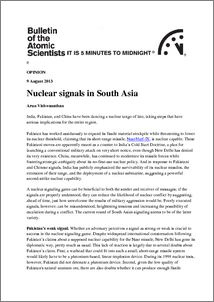Vishwanathan, Arun
(2013)
Nuclear signals in South Asia.
Bulletin of the Atomic Scientists.
ISSN 1938-3282.
![[img]](http://eprints.nias.res.in/style/images/fileicons/application_pdf.png)  Preview |
|
PDF
Bulletin_Nuclear_Signal_Article_August_9_2013.pdf
- Published Version
Download (63kB)
|
| Abstract: |
India, Pakistan, and China have been dancing a nuclear tango of late, taking steps that have
serious implications for the entire region.
Pakistan has worked assiduously to expand its fissile material stockpile while threatening to lower
its nuclear threshold, claiming that its short-range missile, Nasr/Hatf-IX, is nuclear capable. These
Pakistani moves are apparently meant as a counter to India’s Cold Start Doctrine, a plan for
launching a conventional military attack on very short notice, even though New Delhi has denied
its very existence. China, meanwhile, has continued to modernize its missile forces while
fostering strategic ambiguity about its no-first-use nuclear policy. And in response to Pakistani
and Chinese signals, India has publicly emphasized the survivability of its nuclear missiles, the
extension of their range, and the deployment of a nuclear submarine, suggesting a powerful
second-strike nuclear capability. |
| Item Type: |
Journal Paper
|
| Subjects: |
International Strategic and Security Studies Programme > Security Studies |
| Divisions: |
Schools > International Strategic and Security Studies Programme |
| Date Deposited: |
11 Nov 2013 10:09 |
| Last Modified: |
08 May 2015 10:06 |
| Official URL: |
http://www.thebulletin.org/nuclear-signals-south-a... |
| Related URLs: |
|
| Funders: |
UNSPECIFIED |
| Projects: |
UNSPECIFIED |
| DOI: |
|
| URI: |
http://eprints.nias.res.in/id/eprint/383 |
Actions (login required)
 |
View Item |


